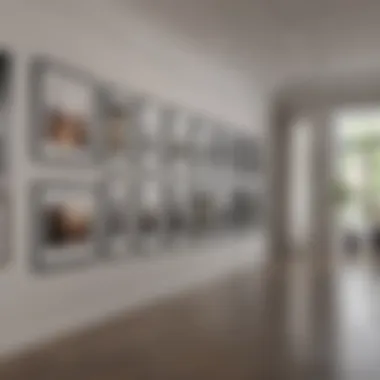Techniques to Hang Multiple Pictures Aesthetically


Intro
Hanging multiple pictures on a wall can transform a blank space into a captivating visual narrative. When done thoughtfully, it not only showcases personal taste but also enhances the overall ambiance of a room. This article explores essential techniques and tips for creating a cohesive and aesthetically pleasing display of wall art, applicable to both small and large spaces.
By understanding layout planning, spacing, and framing options, readers can curate their artwork with purpose and intention. This practical guide aims to inspire a thoughtful approach to hanging pictures, ensuring an engaging and visually appealing outcome.
Architectural Inspiration
Overview of Design Styles
When considering how to display multiple pictures, understanding the architectural context is essential. Different design styles, such as modern, rustic, or minimalist, influence the arrangement of your artwork. Each style carries its own unique characteristics:
- Modern Design: Clean lines and a mix of geometric shapes are key. Arrangements often favor asymmetry and negative space.
- Rustic Design: This style embraces warmth and texture. Incorporating wooden frames or natural elements can harmonize with other materials.
- Minimalist Design: Focusing on simplicity, the layout typically consists of fewer pieces with more breathing room between them.
Understanding these styles can help create a more integrated and intentional look in your home.
Innovative Materials and Techniques
In recent years, innovative materials and techniques have emerged for displaying artwork. Consider the following:
- Gallery Rails: These allow flexibility in changing artwork without leaving holes in the wall.
- Magnetic Frames: Easy to swap out images, magnetic frames elevate the display with minimal effort.
- Lighting Elements: Incorporating LED lights can highlight specific pieces and create an inviting atmosphere.
Exploring these materials can elevate your wall art experience by introducing versatility and creativity.
Interior Design Trends
Color Schemes and Their Psychological Effects
The color palette surrounding your wall art significantly impacts how it is perceived. Different colors evoke distinct emotions:
- Blue: Calming and peaceful, making it suitable for bedrooms or relaxation spaces.
- Yellow: Invokes happiness and energy, ideal for social areas.
- Green: Promotes balance and tranquility, perfect for living spaces.
When hanging multiple pictures, consider how the colors in your artwork interact with your walls and furnishings.
Space Optimization Tips
Maximizing your wall space can create a more engaging display. Here are some tips to consider:
- Use floating shelves for a layered look that enhances depth.
- Group smaller frames for dynamic visual interest.
- Create a focal point using a central larger piece and build around it with smaller works.
These strategies help not only to showcase your collection but also to optimize the use of space in your home.
Prolusion to Wall Art Displays
Hanging multiple pictures on a wall is not simply a matter of placing items on a surface. It involves consideration of aesthetics, themes, and how different pieces interact with each other within a space. This section establishes the foundational understanding necessary for creating impactful displays that do more than fill an empty area. They transform and redefine a room's atmosphere.
Art plays a crucial role in personal expression. It reflects tastes, interests, and experiences—all vital elements in curating an environment that resonates on a personal level. Moreover, an art display can serve as a conversation starter and an emotional connector, inviting guests into the life of the homeowner.
Defining the Importance of Wall Art
Wall art serves multiple functions in a home. Firstly, it can anchor a room, providing character and focus. This is especially important in large spaces where walls can feel vacant and uninspired without art. Secondly, wall art impacts mood. Different colors, styles, and themes can evoke various emotions. For instance, bold colors may rejuvenate energy, while softer tones may induce calmness.
By thoughtfully selecting and positioning art pieces, it is possible to manipulate how a room feels. Therefore, understanding the importance of wall art is essential for anyone interested in interior design. One must also factor in personal connections. Family photographs, for example, hold sentimental value and add warmth to the home.
The Role of Aesthetics in Home Design
Aesthetics in home design goes beyond just visual appeal. It involves harmony and balance which contribute to the overall experience within a space. Achieving such aesthetics requires thoughtful consideration in selection and arrangement of art. This process can elevate a mundane room into an inspiring one.
Considerations regarding color schemes, textures, and themes must align with the existing decor. A cohesive aesthetic can unify different areas of a home, making it feel tailored and curated.
- Color: The colors in artwork can echo or contrast the colors present in furniture and walls.
- Style: Selecting a style, whether modern, rustic, or eclectic, ensures that the art complements the room rather than overwhelms it.
- Texture: Different textures can add layers of interest. Mixing framed and unframed pieces or varying frame styles can create depth.
"Art is not what you see, but what you make others see." - Edgar Degas
This foundational understanding will pave the way for creating a visually engaging and personally meaningful art display.
Planning Your Display
The process of planning your display is crucial when it comes to hanging multiple pictures on a wall. This phase lays the groundwork for an organized and aesthetically pleasing presentation. A well-planned display can create a focal point in the room and enhance the overall ambiance, inviting attention and admiration. Conversely, hasty decisions can lead to a cluttered look, detracting from the beauty of the artwork.
Measuring Wall Space
To begin with, accurate measurements of your wall space is essential. Not only does this ensure that you select the right size and number of pieces, it also helps to visualize the arrangement. Use a measuring tape to find the dimensions of the wall you’re planning to use. Consider the height at which you would like to hang each piece. Typically, artworks should be placed at eye level, roughly 57 to 60 inches from the floor. This measurement can vary based on your personal preferences and the height of your space.
Additionally, take note of surrounding furniture or elements that could affect the placement. For instance, a large sofa may dictate a larger wall configuration.
Selecting Artwork Themes
Selecting a cohesive theme for your artwork is another vital aspect when planning your display. Themes can reflect your personality, interests, or even the mood of the space. It can range from nature and landscapes to abstract art or family photography. The key is to create harmony among the pieces. This doesn't mean every piece has to be the same. Instead, choose artworks that share a common color palette or style. For example, black and white photography can complement colorful paintings elegantly.
Additionally, cultural and personal backgrounds can play into theme selection. Art that reflects your heritage, travels or significant life events makes your display unique and personal.
Creating a Mood Board


A mood board serves as a visual representation of your ideas. It helps in refining your thoughts about the display. To create one, gather images of the artworks you consider including. You can either use physical prints or digital images. Arrange them on a board to see how they interact with one another.
Incorporate color samples, fabric swatches, or even pieces of décor that inspire you. This exercise aids in visualizing the final look before committing to the arrangement.
Moreover, it serves as a reference point during the execution phase, ensuring that your final display aligns with your vision.
Remember: A well-thought-out plan sets the stage for a successful art display, guiding you through the process and minimizing errors.
Choosing the Right Artwork
Choosing the right artwork is a pivotal element of creating an aesthetically pleasing wall art display. The artwork selected can set the mood, reflect personal taste, and even influence how space is perceived by viewers. It is essential to think not just about what looks good, but also how the chosen pieces interact with each other and the surrounding environment. When artworks resonate with the viewer’s experiences or beliefs, they create a stronger emotional connection, enhancing the overall impact of the display.
Here are several key factors to consider:
- Personal Preference: The artwork should reflect the homeowner's personal style and taste. This creates warmth and a welcoming atmosphere.
- Color Coordination: The colors in the artwork should harmonize with the room’s color scheme. This balance helps unify the space.
- Scale and Proportion: Consider the size of the artwork in relation to the wall and room dimensions. Larger pieces can serve as focal points whereas smaller pieces can complement
Types of Artworks: Photographs vs. Paintings
When exploring types of artworks to display, a foundational question arises: photographs or paintings? Each genre offers distinct qualities and evokes different responses.
Photographs bring a sense of realism and modernity. They often capture moments in time, making them relatable for viewers. Using photographs from personal travels can add a personal touch to a display. On the other hand, paintings offer an artistic interpretation of a scene or emotion. They can introduce texture and depth through brush strokes and color mixing. By blending both mediums, one can achieve a diversified and dynamic arrangement that appeals to various artistic appreciations.
Using Personal and Cultural Images
Integrating personal and cultural images into wall displays can be particularly striking. These images serve more than decorative purposes; they can tell a story. Whether through family photographs, art that reflects one’s heritage, or travel-inspired pieces, personal images can convey values and memories that resonate deeply with the viewer.
- Family Portraits: These can create a sense of belonging and identity. Their emotional value often outweighs their artistic merit.
- Cultural Artworks: Including art that represents one’s culture can enhance cultural appreciation and provide educational value to visitors.
- Travel Photography: Images from travels can evoke nostalgia and curiosity. They spark conversations and inspire others to explore.
Selecting the right artwork is about finding pieces that not only enhance the visual appeal but also connect with personal and cultural narratives.
Arrangement Techniques
The arrangement of multiple pictures on a wall is not merely about placing frames haphazardly. It is a crafted practice that reflects personal taste while also catering to the inherent dynamics of spatial design. The arrangement techniques can significantly influence both the visual appeal and emotional impact of a space. A well-thought-out arrangement can unify various artworks, create balance, and bring a cohesive aesthetic to a room.
When deciding how to arrange pictures, it is essential to consider the size of the wall, the nature of the artworks, and the overall theme of the interior. Here are some commonly used techniques that can enhance any display:
Grid Arrangement: Structure and Consistency
Grid arrangement is a method known for its orderliness. It involves placing artworks in a straight line, often using equal spacing to create a clean and straightforward presentation. This technique is particularly effective in modern settings, where minimalism is often favored. The benefits of grid arrangements include:
- Predictability: The uniformity makes it easy to anticipate how the display will look.
- Layering: This method allows for layering bit-sized frames alongside larger pieces.
- Focus: Grid arrangements draw the viewer’s eye across the wall, preventing any one piece from dominating the space.
To execute a grid arrangement, first measure the space. Consider how many pieces to include and their individual sizes. Mark the placement with a pencil before drilling any holes.
Salon Style: Eclectic Compositions
In contrast to grid placements, salon style arrangements embrace a freer, more eclectic composition. This technique allows for various sizes, styles, and orientations of pieces to coalesce into a dynamic display. Benefits of this style include:
- Visual Interest: It creates intrigue through diversity.
- Personal Expression: Each artwork’s individuality can shine, telling a story about the collector’s taste.
- Adaptability: Salon style arrangements can fill odd spaces and bring warmth to a room.
To achieve this, start by laying out your pieces on the floor, experimenting with different configurations until you find something that feels right. Use varying frame styles and colors for added texture and depth.
Linear Arrangement: A Minimalist Approach
The linear arrangement is characterized by a streamlined presentation. This layout often features art in a single row, which promotes clarity and simplicity. Such an arrangement works well in narrow spaces, hallways, or above furniture, providing a clean visual line. The key advantages are:
- Simplicity: This method emphasizes each individual piece without distractions.
- Flow: A linear arrangement can guide the viewer’s eye smoothly across the artwork.
- Space Management: It’s an excellent choice for displaying pieces where vertical room is limited.
When designing a linear arrangement, maintain consistent spacing to ensure harmony. Consider using pieces of similar height for a more aligned look.
Each of these techniques offers unique advantages that can dramatically alter the impact of your wall art. Whether aiming for a structured grid, a vibrant salon style, or a minimalist linear display, understanding the principles of arrangement can lead to a more aesthetically pleasing environment. Remember, it’s not just about how the artworks are hung, but how they resonate with the viewer.
Spacing and Alignment
Establishing the right spacing and alignment when hanging multiple pictures on a wall is essential for achieving a harmonious visual display. Proper spacing is crucial as it can significantly affect how the artwork is perceived by the viewer. Each piece of art plays a role in the overall look and feel of the space. Therefore, understanding how to effectively space and align your frames can enhance the aesthetic appeal of the whole room.
Good spacing between frames allows the individual pieces to breathe. When pictures are too close together, they may appear cluttered or chaotic. On the other hand, if they are spaced too far apart, it can seem as if the artwork lacks connection. Optimal spacing usually ranges from 2 to 6 inches, but this can vary based on the size of the frames and the wall space available.
Optimal Spacing Between Frames
When deciding on where to place your artwork, consider the sizes and styles of your frames. Large frames often benefit from slightly more spacing, allowing them to stand out without overwhelming the viewer. Smaller frames can be clustered more closely together, creating a gallery effect.
Here are some points to think about:
- Frame Size: Larger frames need more space because they naturally attract attention.
- Wall Size: A small wall may look busy if the spacing is generous, while a large wall might look empty with tight spacing.
- Theme and Style: Matching the spacing with the overall theme creates a coherent story in your display.
To visualize this, you could lay the artworks on the floor before committing to the wall. This trial can help determine the spacing that feels right.
Aligning for Visual Cohesion
Aligning your frames properly contributes to the overall cohesion of the display. You can choose to hang frames according to a horizontal or vertical line. The key is to maintain a consistent visual level across the entire artwork cluster.
Factors to consider include:
- Thematic Unity: Group artworks that share a similar theme or style to create impact.
- Alignment Methods: Use level tools to ensure that frames are not misaligned. A slight tilt can be distracting and detract from the artwork.
- Frame Shape and Size: If you mix different sizes and shapes, think about how they relate to one another. Aligning the top edges of each frame may create a cleaner look, whereas a staggered effect can add dynamism.


The alignment of your artwork influences not just aesthetics but also the viewer’s experience. A well-aligned display invites admiration and encourages viewers to engage fully with each piece.
As a final recommendation, take your time with both spacing and alignment. Adjust frames as necessary until you find a balance that feels right. Your art display should not only reflect your personality but also engage and inspire those who view it.
Mounting and Hanging Techniques
Mounting and hanging techniques are vital elements in the process of displaying multiple pictures on a wall. Their importance lies in ensuring that artwork is not only beautified but also anchored securely. A well-executed technique can significantly impact the overall presentation and longevity of the display.
The choice of mounting methods directly affects how the artwork interacts with the wall space and each other. Various factors influence this decision including the weight of the artwork, wall material, and the desired aesthetic. When selecting the appropriate techniques, it is crucial to consider functionality and visual impact simultaneously.
Selecting Appropriate Wall Fixtures
Choosing the right wall fixtures is fundamental for a secure and aesthetically pleasing display. Wall fixtures vary widely. Some common options include picture hooks, adhesive strips, and mounting brackets. Each of these serves distinct purposes and supports different weights.
Picture hooks are versatile and cater well to frames of various styles and sizes. They offer a straightforward way to hang pictures with minimal wall damage. Adhesive strips, on the other hand, provide a clean look without any hardware visibility. Though they are easier to use, it is essential to check weight limitations and removal methods to avoid damage during changes.
Mounting brackets usually support heavier frames; these fixtures can carry significant weight, making them suitable for bigger pieces or multiple artworks stacked together. Additionally, shimmy screws into the wall, which can help distribute weight evenly, should be considered in heavy-duty applications.
Using Leveling Tools for Precision
Precision in hanging pictures cannot be overemphasized. Using leveling tools is essential to ensure that all pieces are aligned correctly. A level will prevent the frustrating scenario where a frame looks askew. There are various types of leveling tools available, including laser levels and traditional bubble levels.
When using these tools, start by measuring the height at which you want to hang your artwork. Mark this point on the wall. Next, use the leveling tool to draw a horizontal line across the marked height. This line serves as a guide for placement, ensuring that each piece aligns seamlessly with one another.
Incorporating a measuring tape can be helpful for maintaining consistent spacing between frames, as precise alignment contributes to an overall polished look. Finally, double-check the level after each piece is hung to ensure that they remain straight; adjust as necessary to avoid any imperfections.
By paying attention to the mounting and hanging techniques, you uphold the integrity of your art display while achieving a polished appearance. These steps lay a firm foundation for the overall visual impact of an arranged wall art display.
Enhancing Visual Impact
Enhancing visual impact is essential when hanging multiple pictures on a wall. It transforms a simple collection of images into a cohesive and striking display. By focusing on specific elements, such as accessories and lighting, one can significantly elevate the aesthetics of the artwork. This section will delve into how these components contribute to the overall visual appeal of a space, making it more inviting and refined.
Incorporating Accessories and Decor
Accessories play a crucial role in enriching the display of wall art. They can create context and enhance the meaning behind your chosen images. A well-placed shelf, for instance, allows for the display of small sculptures or books that complement the artwork. Consider using vases or decorative objects that reflect the colors or themes present in your pictures.
- Choose Colors Wisely: Select accessories that echo color palettes found in the artwork. This creates a unified look.
- Sizes and Shapes: Vary the sizes and shapes of accessories to create visual interest. For example, pair large pieces with smaller ones to avoid overwhelming the wall.
- Theme Cohesion: Maintain a consistent theme across all decorations. For instance, if your wall art features nature landscapes, consider adding plants or botanical elements around it.
By thoughtfully incorporating accessories, you enhance the storytelling aspect of your display while keeping the viewer engaged.
Lighting Techniques to Highlight Artwork
Proper lighting significantly impacts the perception of wall art. It can bring out colors and details that may be otherwise overlooked. By employing specific lighting techniques, you can create a dramatic effect or add subtle elegance to your display.
- Spotlighting: Use adjustable spotlights to highlight focal points. This draws the eye directly to the artwork, emphasizing its importance.
- Wall Wash Lighting: A soft wash of light can illuminate a larger area. This is beneficial for gallery-style displays where multiple pieces are featured.
- Natural Light: If possible, position artwork near windows to take advantage of natural light. However, be mindful of direct sunlight, as it can fade artwork over time.
Proper lighting not only enhances visual appeal but also transforms the atmosphere of your space.
In summary, enhancing visual impact through accessories and lighting is crucial in achieving an aesthetic wall display. By focusing on these elements, you can create a space that captivates attention and reflects your personal style.
Common Mistakes to Avoid
Hanging multiple pictures on a wall can be an exciting endeavor, but it is easy to make common mistakes. Recognizing and avoiding these pitfalls can dramatically enhance the aesthetic quality of your wall displays. A cohesive arrangement does not just occupy space; it transforms a area into a personalized gallery. When engaging with wall art, one must understand the nuances that can contribute to ineffective displays.
Overcrowding the Wall
One of the most prevalent errors in creating wall art displays is overcrowding the wall with too many pieces. When too many artworks, photographs, or prints compete for attention, the effect can become chaotic. Instead of a unified look, the wall may appear cluttered and overwhelming. It is essential to evaluate the available space before committing to any arrangements.
A well-hung display should have breathing room. Each piece needs the space to be appreciated without a distraction from adjacent frames. Aim for a balance between your artwork and the wall space. Group similar-sized pieces, and provide a consistent spacing of about two to four inches between frames. This helps each piece stand out while retaining an integrated look.
Neglecting to Consider Room Functionality
The failure to consider how a wall display interacts with the room’s functionality is another mistake that can undermine the overall design. Each room has a purpose; for instance, a living room may promote conversation, while a home office should encourage focus. Therefore, the art hung in these spaces should support their functions.
Consider the viewer’s perspective when deciding where to hang your art. In a busy area, like a hallway, art should be accessible but not obstructive. In spaces meant for relaxation, such as bedrooms, more soothing and less chaotic arrangements work best. Moreover, avoid placing significant art pieces in areas where they could easily be damaged or overlooked. This will ensure that your wall art not only beautifies the space but also aligns with its intended use.
Remember, thoughtful placement of artwork contributes to the overall flow of a room.
By being mindful of these common mistakes, you will achieve a more harmonious and aesthetically pleasing display in your home.
Adapting to Different Spaces
Adapting artwork displays to different spaces is crucial in maximizing the visual impact of your wall art. Spaces vary widely, influencing how art is displayed. A small room, for example, requires different considerations than a large gallery. Understanding these differences leads to effective artwork curation.
Creating Artwork Displays in Small Rooms
Small rooms can feel cluttered easily, making it essential to select and hang artwork mindfully. When arranging pieces in confined spaces, consider the following:
- Size of Artworks: Opt for fewer, larger pieces rather than many small ones. Larger artworks can create a focal point and reduce the feeling of overcrowding.
- Vertical Space: Utilize vertical space by hanging pieces higher up. This trick draws the eye upward, making the room feel taller.
- Mixing Frames: Use a combination of frames, but keep them consistent in color. This practice allows for a cohesive look without overwhelming a small area.


Ultimately, choose art that complements the room's purpose. A calming piece might work well in a bedroom, while energetic pieces could enhance a workspace.
Utilizing Gallery Spaces Effectively
Gallery spaces offer unique opportunities for displaying artwork. The layout often allows for more freedom and creativity. Consider these strategies for an effective gallery display:
- Theme Coordination: Create a theme that connects the pieces. This consistency can enhance viewer experience.
- Spacing Between Pieces: Unlike smaller spaces, galleries benefit from generous spacing. This practice allows viewers to appreciate each piece individually without distraction.
- Lighting: Implement directed lighting to highlight each artwork. Track lighting or spotlights can enhance the visual appeal dramatically.
Adapting to various spaces improves not only aesthetics but also the viewer's engagement with the art. Whether in small rooms or expansive galleries, thoughtful arrangement transforms how art impacts its environment.
"Art needs space to breathe, allowing viewers to connect with it in a meaningful way."
Understanding these considerations can lead to stunning displays that genuinely reflect your style and the characteristics of the space.
Sustainable Practices in Art Display
In today’s world, where environmental concerns are prevalent, incorporating sustainable practices into home decor becomes essential. Art displays, being a significant component of interior design, need to align with these ecological values. Sustainable practices encompass a variety of strategies that not only contribute to preserving our planet but also enhance the aesthetic charm of your wall displays.
One main element of sustainable art display is the choice of the materials used. Eco-friendly materials, when selected, can help minimize environmental impact while still ensuring visual appeal. Additionally, supporting local artists fosters community engagement and reduces the carbon footprint associated with transporting artworks over long distances.
The benefits of embracing sustainability in art display are manifold. Besides appealing to environmentally conscious individuals, it enables creativity and encourages unique designs that reflect personal values. This approach also educates others about the importance of sustainability. By using art as a medium, one can spark discussions about eco-friendliness in broader society.
Choosing Eco-Friendly Materials
Choosing eco-friendly materials is crucial for those who aim to maintain a sustainable art environment. This involves selecting frames, mats, and even artworks that are made from sustainable or recycled resources. For instance, bamboo frames are an excellent alternative due to their rapid growth and renewability compared to traditional wood. Furthermore, prints made on recycled paper or materials can create beautiful visuals without excessive environmental damage.
It's also essential to be aware of the paints and finishes used on artworks. Opting for low-VOC (volatile organic compounds) paints can significantly reduce harmful emissions in your living space. Prioritizing these eco-friendly materials not only contributes to sustainability but aligns your decor choices with a broader ecological consciousness.
- Recycled Materials: Use frames made from recycled products.
- Sustainable Wood: Choose bamboo or certified wood frames.
- Low-VOC Paints: Opt for paints with low environmental impact.
- Natural Fibers: Consider artworks made from jute, linen, or organic cotton.
Support Local Artists
Supporting local artists is another impactful aspect of sustainable art display. By purchasing artworks from local creators, you not only help enhance the community's economy but also reduce environmental costs associated with shipping. Local artists often draw inspiration from their surroundings, making their work a reflection of local culture and nature.
Engaging with local art scenes creates a deeper connection to the community as well. It allows art lovers to become part of a narrative rather than merely consumers of mass-produced works. Moreover, unique pieces reflect personal taste more profoundly than generic art, leading to a space that feels more individualized and authentic.
In addition, many local artists are inclined to use sustainable materials. By choosing their work, you often support eco-friendly practices as well. Making a deliberate effort to seek out and buy from these artists enriches your home decor while championing a crucial cause.
Sustainability in art display isn't just about how we adorn our walls; it’s about making conscientious choices that resonate with our values and aesthetics.
Overall, sustainable practices in art display play a pivotal role in modern home design. By selecting eco-friendly materials and supporting local artists, individuals can create attractive, meaningful, and responsible art displays that reflect a commitment to sustainability.
Maintenance of Art Displays
Maintaining art displays is crucial for preserving not just the artworks but also their aesthetic impact on your living space. Over time, various factors can affect the condition of wall art, including dust, humidity, and light exposure. Neglecting proper maintenance can lead to fading, discoloration, or even physical damage to the pieces. Therefore, establishing a routine for the care of your art collection helps keep it looking fresh and vibrant.
One essential aspect of maintenance is cleaning. Regular dusting can inhibit the build-up of grime that can dull the appearance of both the artwork and the frame. Depending on the materials used in the artwork, different cleaning methods and products are necessary to minimize damage. For instance, delicate oils and varnishes on paintings require gentle care, while photographs can often be cleaned with a simple microfiber cloth.
Preserving artwork also involves protecting it from environmental hazards. Understanding where to place art can significantly help in this regard. Hanging pieces in areas with less humidity or direct sunlight can prolong their life. Using UV-protective glass when framing can also reduce the risk of fading caused by sunlight. These considerations are integral for anyone engaged in curating their own wall art.
"Proper maintenance not only enhances the longevity of the artwork but also preserves the emotional connection it invokes in your space."
In summary, diligent maintenance of art displays involves both cleaning and protecting your valuable pieces. Taking these steps can ensure that the artwork continues to contribute to the visual appeal of your home over the long term.
Cleaning and Preserving Artwork
Cleaning and preserving artwork should be taken seriously. Dust and other particles can accumulate on surfaces, leading to deterioration over time. As mentioned, a soft microfiber cloth often serves well for most framed pieces, including prints and photographs. For paintings, using a breath of air to remove dust may suffice, but professional cleaning may be recommended for valuable works.
Furthermore, artworks on canvas or wood can be at risk of moisture damage; therefore, it's advisable to monitor humidity levels in the room. If you notice signs of wear or aging, consult an expert to recommend the best preservation methods. Taking proactive measures can protect your investment and allow future generations to enjoy these pieces.
Adapting Displays Over Time
Art displays should not be static. Adapting displays over time allows homeowners to refresh their living spaces and keep the environment engaging. Life changes can inspire new arrangements. Whether moving to a new home, adding new pieces, or simply wanting a change, flexibility is key.
Consider shifting the artwork seasonally to reflect new themes or moods. Reassessing what artwork resonates with you can create a dynamic home atmosphere. Additionally, swapping pieces with family or friends can bring a sense of novelty without substantial cost.
When redesigning your space, ensure that layouts still align with your originally intended visual impact while reducing overcrowding by carefully selecting which pieces complement each other. This adaptability leads to a continually evolving aesthetic that can excite and inspire.
The End
In the context of this article, the conclusion highlights the significance of well-executed wall art displays. Through a combination of research-based techniques and practical tips, readers learn how to optimize their spaces. The overall aesthetic appeal of a room is deeply influenced by the art arrangements chosen, helping to transform plain walls into focal points.
Additionally, the conclusion encourages a reflection on the themes discussed. By summarizing the key principles, it solidifies the understanding of spacing, alignment, and selection of artwork. A cohesive display does not only beautify a space but also communicates the personality of the inhabitants.
Summarizing Key Takeaways
When hanging multiple pictures, several critical considerations emerged:
- Plan Your Display: Carefully measure the wall space to determine layout and arrangement options.
- Choose Artwork Wisely: Select pieces that resonate with you personally. This could include family photographs or culturally significant art.
- Create Cohesion: Use consistent spacing and alignment. This will contribute to a unified look despite different styles of frames or artwork.
- Utilize Versioning: Don’t set your displays in stone. Artworks can be rotated or updated to keep the display fresh.
These points serve as a roadmap for anyone looking to enhance their spaces through art.
Encouraging Exploration of Personal Style
Artistic expression is a personal journey. As one decorates with multiple pictures, it is crucial to embrace individual style and taste. The way art is displayed can reflect personal experiences and preferences, creating a unique space. Experimentation with combinations of different types of art—be it modern, classic, or personal collections—is encouraged.
Consider seeking inspiration from various sources, such as interior design blogs or social media platforms. Each room offers a blank canvas to experiment on. Follow the principles and techniques discussed, but always feel free to stray from conventional norms. It is this exploration that allows for authenticity and creativity to shine through.







